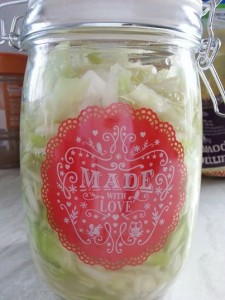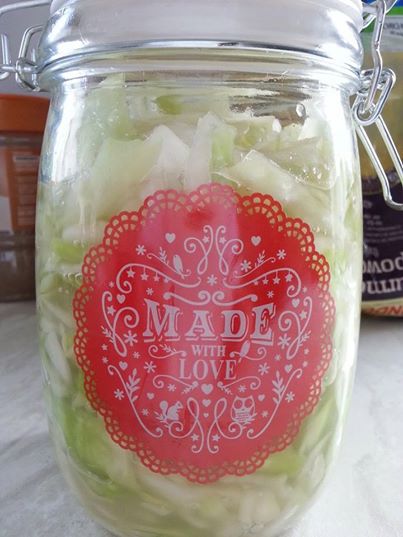Fermented foods have a long tradition in all cultures, and we have long forgotten the importance of having them in our diets. People would of eaten them everyday, giving them great bowel health, and higher immunity. Depending on the types of foods you ferment and you can play with lots you can be accompanying every meal with them. They are powerfully probiotic rich, so take it slowly at first, drinking a gallon of kefir will ensure that your bowels are functioning!
The downside….well unfortunately lots of our pickled and fermented foods that are sold in the shops are pasteurised, which kills off the bacteria that is the beneficial side of eating them. So apart from a couple of suppliers you will have to make it yourself, but this means it is extremely cost effective.
Saurkraut
You will need:
1 Cabbage, I do a mixture of red and white, working them separately then putting them stripey in the jar!!
A Mason Jar with a heavy plate to put on top
1.5 tblsp Himalayan or Celtic Sea Salt
It’s really easy
-
Shred the cabbage, fairly finely.
-
Put into a very large mixing bowl.
-
Massage the salt into the cabbage, the cabbage will start to become limp, and allow the juices to come out of it. Do this for about 10 minutes.
-
Put this into your jar, make sure the cabbage is covered with it’s own brine juice, if not add a little more water and some salt. Put a plate on the top to weight it down, and then cover with the lid.
-
Put somewhere safe, not too warm, not too cold.
-
Occasionally check, press the plate down to keep the pressure on it.
-
When it’s fermenting it will start to bubble slightly, hurrah. This will go on as long as it’s out of the fridge.
-
Depending on how much you have made, it will take anything from a week to 2 weeks to be ready to eat. Put it into the fridge will in effect stop the fermentation process.
I told you it was easy!
